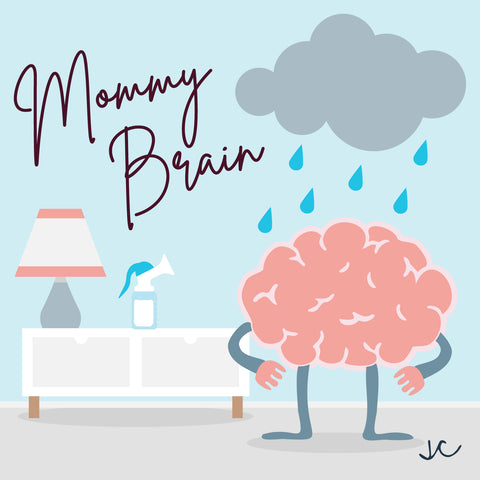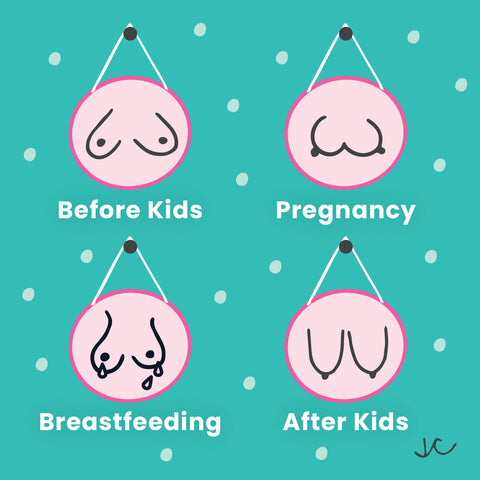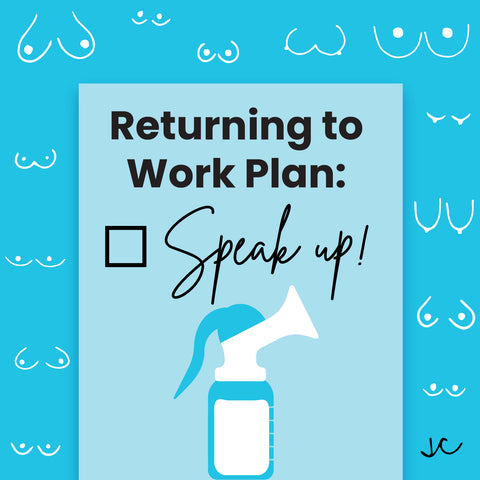How is breast milk made?

Estimated read time: 13 minutes
Your magical milk is Mother Nature's perfect baby food.
Boobies, believe it or not are actually a gland made (mostly) of connective and fatty tissues that both support and protect the milk-producing areas of your breasts.
How awesome is that?
And when it comes to your breast milk, it’s not actually made in the nipples, but in a small cluster of cells called alveoli. When milk is produced, it travels from your alveoli down the ducts of your nipples and into the hungry mouth of your gorgeous little babe.
But, how is breast milk made? What goes into breast milk production, and what makes up your breast milk composition?
Never fear mama, we’re here to break it all down and tell you everything you need to know about your liquid gold.
How is breast milk made?
Your milk is a truly amazing fluid.
Not only is it highly nutritious and comforting, but it can also help protect your baby from various infections and diseases.
Your breast milk also changes over time, making your Titties produce different types of breast milk to meet your hungry baby’s needs. It even adjusts its composition throughout the day, adapting itself to keep up with your little one’s demands and sleep schedule (producing more tryptophan – the precursor to the sleep hormone melatonin – at night).
Let’s take a look at your beautiful Boobs so we can get a better understanding of how they work.
Your breast is surrounded by skin with an area called the areola in the middle. This area of skin is a darker color than the rest of your Boob and your nipple protrudes happily from the center. When your baby nurses, they latch onto the areola with the nipple hitting the top of their mouth. Your nipple has 15-20 openings for your milk to flow from. A good latch is super important both for breast milk production and for comfortable feeding.
Ever notice those little bumps surrounding your areola?
Those bumpy beauties are called Montgomery glands and they also have a super important role when it comes to breast milk production. They produce an oil that cleans and moisturizes the whole area, keeping your Boobies fresh and perfect for your baby’s mouth.
Inside the breast
OK, so we’ve got the outside covered. What about what’s going on inside your pretty Titties?
There are several magical things happening inside your Boob thanks to its clever structure.
Inside you have:
- A bunch of connective tissue and little ligaments that support your Boobs
- Fatty tissue (also known as adipose) that protects your marvelous milk makers
- Glandular tissue – this is the amazing tissue that contains milk ducts and alveoli that actually makes your milk
- The alveoli themselves that make your milk
- Milk ducts act like little streets and carry your milk from the alveoli through your Boobies
- Myoepithelial cells that contract and push out your milk from glandular tissue through the ducts
- A bunch of nerves that send signals to your brain from your nipple and areola to make your breasts release milk and start producing more
I mean. How freaking amazing is that?
All that magic happens inside a mama’s Boobs without us even knowing.
Kinda blows us away!
Breast milk production
Let’s quickly take a look at some of the incredible components in your breast milk:
- Water
- More than 1,000 proteins
- Carbohydrates/lactose
- Various fats
- Antibodies – all 5 basic forms of antibodies are in your milk and protect your baby from illnesses and infections
- Vitamins
- Growth factors – support healthy development
- Minerals
- Amino acids – some of them can induce sleep
- Human milk oligosaccharides – prebiotics that feeds “good bacteria” in your baby’s gut
- 800 strains of bacteria
- Long-chain fatty acids – help build your baby’s nervous system and aid healthy brain and eye development
- Live cells – including white blood cells and stem cells
- Hormones – help send messages between tissues and organs to ensure they work properly
- More than 40 enzymes help aid your baby’s digestion and immune system
Now, although the onset of breast milk production is triggered by the delivery of your placenta (resulting in a sudden drop in progesterone levels), did you know that your Titties can start producing milk even BEFORE you give birth?
Your developing placenta stimulates the release of estrogen and progesterone, which stimulates milk production.
Yep, breast milk production starts amping up during your second trimester, so even if you give birth prematurely, you should still be able to feed your little one.
So don’t be surprised if you leak a few drops now and then when your bump is growing!
Breastfeeding is a supply and demand (or even demand and supply) process, but it doesn’t start out that way.
While you’re pregnant, and in the first couple of weeks, after you give birth, milk supply is hormone-driven, or to call it by its fancy name, the endocrine control system. If all your hormones are in place, you’ll start making colostrum about halfway through your pregnancy (which will be your baby’s first food) and your milk volume will increase around 2-3 days after giving birth.
Frequent breastfeeding stimulates the nerves in your Boobies to send a message to the pituitary gland in your brain. This gland releases the hormones prolactin and oxytocin (the lurrrve hormone).
Prolactin tells your Titties to make milk while oxytocin signals the “let-down” reflex to release the milk. You’ll know about it as it can make your Boobs feel tingly. Your body will keep making milk until you decide to stop breastfeeding.
As you wean, your body will get the message to make less and less milk. As this happens, the glandular tissue in your breasts will shrink down and your Titties will return to their pre-pregnancy state – well, internally at least!
What is colostrum?
Prompted by the hormone prolactin, your alveoli take proteins, sugars, and fat from your blood supply to make breast milk. So the food you eat contributes to the already sweet and creamy flavor of your milk, which can be super beneficial when it comes to introducing solid foods.
And the first breast milk your baby gets to enjoy is called colostrum… otherwise known as “liquid gold,” and for very good reason.
This milk looks different from mature breast milk. It can be clear, white, orange, or yellow, and it’s usually quite thick and kinda sticky. The colostrum breast milk composition is super nourishing and is all your baby will need in the first few days when her belly is teeny tiny (and oh-so kissable!)
It’s nutrient-rich, high-protein, low-fat, and very easy to digest. It’s also higher in minerals, vitamin A, nitrogen, salt, protein, white blood cells, and certain antibodies, and has less sugar and fat than mature Boobie milk.
But what’s really amazing about colostrum is its superpower for fighting diseases and infections, thanks to its antibodies called immunoglobulins. These strengthen your baby’s immune system, giving her the best start in life. Colostrum’s protective qualities are important to your baby’s digestive system too! Babies are born with a permeable gut lining, which colostrum coats and seals.
Oh, and another fun fact about colostrum – it acts as a gentle laxative! Making it easier for your baby to poop and get rid of meconium (the black, tarry stool produced in her bowel while she was in your belly). This can also reduce the risk of conditions such as jaundice.
Although you only produce small amounts of colostrum, it’s all your baby needs for her first few days. Over the following days and weeks, your beautiful Boobies will transition from colostrum to glorious mature milk.
Breast milk composition
We now move on to the different types of breast milk after colostrum.
You might notice in the 2-3 days (although it can take longer) after giving birth that your Boobies swell up a bit.
Hello gorgeous!
This is your “milk coming in,” when your milk changes in both composition and quantity. For the next 2 weeks, this milk is called “transitional milk” and it’s called that because it’s transitioning from colostrum to mature breast milk.
It gets creamier and thicker and has a higher fat, calorie, and lactose quantity than colostrum, while still holding on to the protective antibodies, good bacteria, live cells, and other bioactive ingredients to keep her happy and healthy.
Mature breast milk composition
By the time your sweet little babe is 4 weeks old, your milk will be fully mature.
Your mature milk is made up of the foremilk and the hind milk.
- Foremilk comes when you first start feeding. It’s quite thin and watery with almost a light blue hue. Foremilk contains a lot of water and it helps satisfy your baby’s thirst
- Hind milk gets released after a few minutes of nursing. It has a similar consistency to cream and also contains the highest concentration of fat. Hind milk helps to relax and fill up your baby, satisfying hunger and helping her gain weight
If you ever pump, you’ll notice the difference between the two kinds of milk once the milk has settled in the pump bottle. The hind milk sinks to the bottom while the foremilk settles on top.
Your breast milk is now rich in protein, vitamins, minerals, sugar, growth factors, hormones, live cells, and enzymes (among other bioactive components) to support your baby’s health and development.
Wanna know something truly magical?
If you or your baby is sick, your body will make antibodies to fight it off. And these antibodies become a part of your milk, helping her to fight off any potential bugs too! Your milk also produces higher levels of protective bacteria-fighting enzymes as your baby grows and starts putting anything (and everything) into her mouth. Helping her to fight off germs.
When or if you choose to stop breastfeeding, the last kind of milk you’ll produce is called involutional milk. This is the milk produced at the end of lactation and it’s lower in lactose with a high concentration of protein, fat, and sodium.
How breast milk is made is totally magical
And you are a milk-making goddess mama!
Now you know how breast milk is made and the different types of breast milk, you can see just how incredible your Titties are, and why you should love them with all your heart. You're the Tits!
We’d love to know if you learned something new today. Drop us a comment over on our Instagram page and let us know.
At Titty City Design, we believe that every boobie is beautiful, and that should be celebrated. We are a female-owned and operated, small business here to spread self-love and body positivity with our line of boob apparel, boob accessories, and boob-themed decor and products for the home. A portion of our proceeds goes to help support postpartum people and breast cancer patients.
Products that New Moms Love







